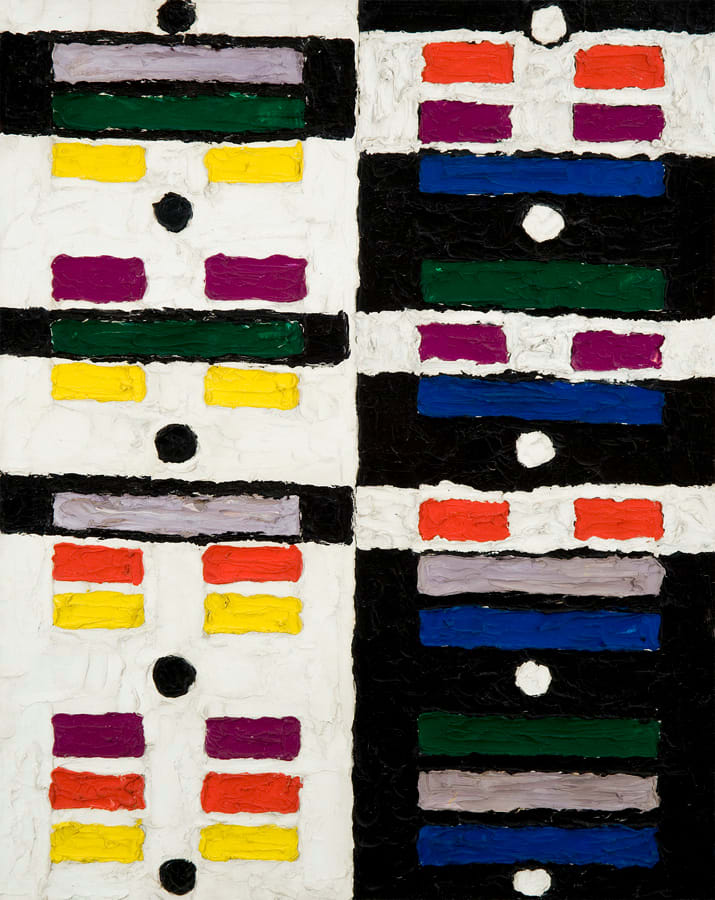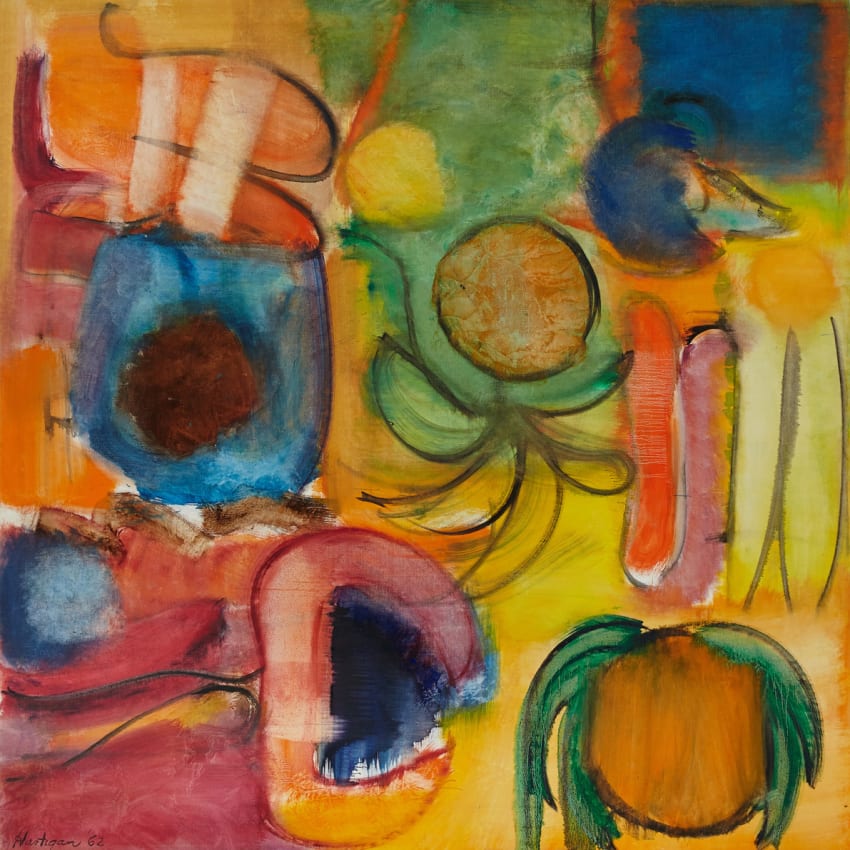
The enigmatic work of Alfred Jensen does not fit neatly into any one movement; rather, his paintings embody the artist’s very personal methodology.
The enigmatic work of Alfred Jensen does not fit neatly into any one movement; rather, his paintings embody the artist’s very personal methodology. His various geometric and numeric systems reference sources in ancient mythology and philosophy that have been translated into the distinctive idiom of the artist, resulting in work that is often difficult but always rewarding. As Peter Perrin explained, “Jensen wants to present a square, a number, a spectrum, a thought process that will appeal to our senses and feelings exactly the same way a landscapist wants a tree, a field, a seashore to reach our senses and feelings, the way the ancient wanted to paint cherries so that birds would try to peck them from the wall.” (1)
Between 1964 and 1970 Jensen worked with ideas based in planetary and mathematical structures. These abstract scientific concepts manifest on Jensen’s canvases as brightly colored bands, bars, and checkers, onto which he applied paint directly from the tube. In 1968, the artist traveled to Guatemala and Mexico’s Yucatan peninsula by plane. The aerial views of both land and heavens that Jensen experienced on this trip inspired a greater interest in astronomy, an interest that becomes apparent in these works.
Jensen meditated on the nature of dichotomy throughout his career, imbuing the oppositions of black and white, odd and even, left and right, up and down with particular importance. Colored grids inhabit the four corners of his works, executed in Jensen’s characteristic bright pigment. All of this is contained within the setting of the “square,” which Jensen described as follows:
“I find in the square specific settings, divisible areas, number structures, possibilities of time, measure and rhythm as well as the essential form of color which can be placed in the square to interplay with number forms.” (2)
Statements such as these are rarely elucidatory, but, as critic Peter Schjeldahl has written, Jensen’s is a “pure” and “generous” difficulty. He goes on: “The sensuous and the cerebral have a nonstop squabble in Jensen’s art, and the friction between them is the very engine of his enterprise: to drive consciousness far afield of present phenomena, off into precincts of the cosmic.” (3)
Early in his career, Jensen demonstrated an interest in theoretical approaches to aesthetics. In the 1930s, he learned of the color theory of Goethe, and he explored Goethe’s ideas during the decades that followed. In 1957, Jensen began employing a checkerboard-like, diagrammatic composition, a structure that would become the foundation of his work. Within these diagrams, the artist encoded systems of world philosophies; in addition to Taoist ideas, Jensen worked with the Mayan calendar, Greek temple plans, and other systems of light and time to create carefully worked, deeply symbolic paintings.
Born in Guatemala to a Danish father and a German-Polish mother, Alfred Jensen had a peripatetic young adulthood. After finishing school in Denmark, he worked on ships, farmed in California, and studied briefly with Hans Hofmann in Munich.
In Germany, Jensen met painter and collector Saidie Alder May, who became his patron and provided Jensen further entrée into the progressive art world. In the late 1920s and into the 1930s, Jensen learned about avant-garde ideas in art. He studied alongside Othon Friesz and Charles Dufresne; the latter would become an important influence. A few years later, he became acquainted with the writing of Auguste Herbin who, in turn, introduced Jensen to Goethe’s theories.
During this period, Jensen began showing his work with key artists of the avant-garde, including Franz Kline, Willem de Kooning, and Joseph Cornell. He showed at the Stable Gallery and Tanager Gallery, and he was represented by the Bertha Schaeffer Gallery, and then beginning in 1959 by the Martha Jackson Gallery. In 1961, his work was the subject of a solo show at the Guggenheim Museum.
Despite Jensen’s apparent standing outside of any established school or style, his work was admired and discussed by many major artists of the period. Two in particular, Donald Judd and Allan Kaprow, found in Jensen a systematic freedom of expression that was not forthcoming elsewhere in contemporary art. Both artists, whose own output was also steeped in personal theory, wrote publicly about Jensen and his important, yet under-recognized place in American art. (4)
Later in the 1960s, Jensen worked as a printmaker at the influential Tamarind Lithography Workshop, where he explored Pythagorean number structures in an important series. He continued to work with numerical and scientific systems while represented by the Pace Gallery in the 1970s. Alfred Jensen passed away in New Jersey in 1981. Jensen's work is held in public collections including the Museum of Modern Art, the National Gallery of Art, the Hirshhorn Museum and Sculpture Garden, the Fine Arts Museums of San Francisco, and the Indianapolis Museum of Art.
1. Peter Perrin, “All the Beautiful Systems.” artscanada, May/June 1979, pp. 40-49.
2. Ibid.
3. Peter Schjeldahl, “Jensen’s Difficulty,” in Alfred Jensen: Paintings and Works on Paper. (New York: Solomon R. Guggenheim Museum), 1985.
4. William C. Agee, “Al Jensen and the Traditions of the Modern,” Alfred Jensen: The Number Paintings. New York: Pace Wildenstein, 29 September-28 October, 2006, p. 7.















